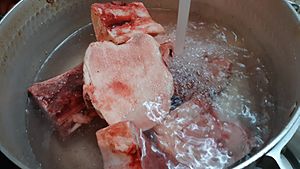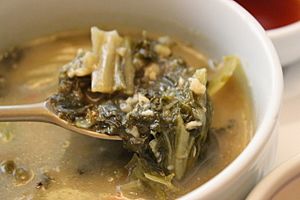Sagol facts for kids

Hanu sagol
|
|
| Place of origin | Korea |
|---|---|
| Associated national cuisine | Korean cuisine |
| Main ingredients | Beef leg bones |
| Korean name | |
| Hangul |
사골
|
|---|---|
| Hanja |
四骨
|
| Revised Romanization | sagol |
| McCune–Reischauer | sagol |
| IPA | [sa.ɡol] |
Sagol (사골; 四骨) is a special ingredient in Korean cuisine. It is also known as beef leg bone. People often boil sagol to make a rich soup base. This base is called sagol-yuksu (사골육수; 四骨肉水), or beef leg bone broth.
This broth is used in many popular Korean soups. Some examples are gomguk (beef bone soup), galbi-tang (short rib soup), and tteokguk (sliced rice cake soup). It is also used in kal-guksu (noodle soup) and gukbap (soup with rice).
Sagol is full of a protein called collagen. It also has important minerals like calcium. In traditional Korean culture, people believed it made the body stronger. However, there is no scientific proof for this idea. In summer, sagol-yuksu is sometimes given to people who are sick or to new mothers. In winter, it is a warm and healthy meal served with rice.
What Does Sagol Mean?
The word Sagol comes from Korean. It roughly means "Four Bones" in English. The word 'Sa' means four, and 'Gol' means bone.
Together, these words refer to the main leg bones of a cow. These are the bones from a cow's upper leg (thigh) and lower leg (shin). People mostly use this term when they are talking about cooking.
Where Do Sagol Bones Come From?
Cows have eight sagol bones in total. These bones come from the thigh and shin bones of a cow's four legs.
Sagol bones can be different based on the type of cow they come from. For example, some come from Hanu cows, which are a special Korean breed. Others might come from different types of beef cattle or dairy cattle. The bones can also be different depending on if they are from a cow, a bull, or a steer.
The best sagol is usually from high-quality Hanu beef. These bones often have a strong, ivory-white look when you cut them open. A sagol bone has a long middle part and two ends. The ends have a hard outer layer and a softer, spongy inside. The middle part has a covering on the outside and marrow inside.


